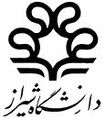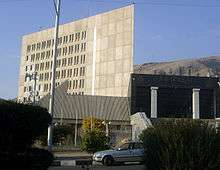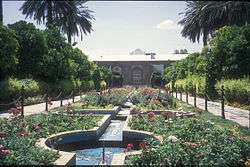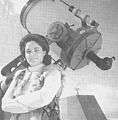Shiraz University
Coordinates: 29°38′23.07″N 52°31′36.3″E / 29.6397417°N 52.526750°E
|
دانشگاه شيراز Dāneshgāh-e-Shirāz | |
 | |
| Type | Public |
|---|---|
| Established | 1946 |
| Endowment | US$ 73.18 million (December 10, 2014) [1] |
| Chancellor | Majid Ershad [2] |
Academic staff | 700 [3] |
| Students | around 21,000 [4] |
| Undergraduates | 11,839 |
| Postgraduates | 7,189 |
| 1,683 | |
| Location | Shiraz, Fars, Iran |
| Campus | Urban |
| Athletics | 12 teams |
| Colors | Dark blue and white |
| Affiliations |
FUIW IAU |
| Website |
shirazu |
Shiraz University (Persian: دانشگاه شیراز Dāneshgāh-e-Shirāz), formerly known as Pahlavi University, is a public university located in Shiraz, Iran. In the latest ranking of Iranian universities based on scientific output, Shiraz University is listed among the top three research-oriented schools in the nation.[5] In the first report of state universities ranking and among almost 70 universities and higher education institutes, Shiraz University is ranked as level 1.[6]
The University of Pennsylvania (Penn) assisted the Iranian government in establishing American-style higher education at the university. Penn thus became highly influential in shaping many of Pahlavi University's departments and institutions. Shiraz University has the second-biggest campus in Iran. It was initially designed by American architect Minoru Yamasaki,[7] who also designed the World Trade Center.
Shiraz University has pioneered the establishment of doctoral programs in Iran. Presently the university has over 20,000 students, with 200 bachelor's degree programs (B.A., B.Sc.), 300 master's degree programs (M.A., M.Sc.), one professional degree program (Doctor of Veterinary Medicine or DVM), and 150 Ph.D. programs.
History
Shiraz University traces its roots to 1946, with the establishment of a technical college aimed at training specialists in the medical sciences with a four-year program.
Initially called the High Institute of Health, it developed into a medical school in 1950. In 1953, the Namazi School of Nursing and the Colleges of Agriculture and Arts and Sciences were established.
With the addition of the College of Engineering and College of Veterinary Medicine in 1954, the school was elevated to university-status and named after the reigning Pahlavi dynasty. Other units that were subsequently added were the Dental School in 1969, the Graduate School and College of Electronics in 1969, Dentistry in 1970 and the Colleges of Law and Education in 1977.

In 1960, Mohammed Reza Pahlavi invited University of Pennsylvania president Gaylord Harnwell to come to Iran and examine Iran's higher education institutions. Harnwell prepared a report at the Shah's request, entitled A Pattern for a New University in Iran, and the Shah subsequently decided that Penn would assist the Iranian government in transforming Pahlavi University[8] into the only institution in Iran based on American-style higher education.[9] The University of Pennsylvania (Penn) thus became highly influential in shaping many of Pahlavi University's departments and institutions.[10] Many faculty members from Penn were hence sent to Shiraz to teach and carry out research at the university, and a widespread exchange program was established. The president of the University of Pennsylvania was even awarded an honorary degree in Shiraz in recognition of the help of Penn to Pahlavi University.[11]
After the 1979 Islamic Revolution overthrew the Pahlavi dynasty, drastic changes were implemented at all universities. The name of Pahlavi University was immediately changed to Shiraz University. All universities were closed for three years in a so-called Iran's Cultural Revolution of 1980-1987 to islamize all the universities.
Seal
The official seal of the Shiraz University serves as the signature and symbol of authenticity on documents issued by the corporation. Before the Islamic Revolution in Iran, a logo was used as the official logo of Pahlavi University inspired by Persepolis. The logo was inscribed with two words; Wisdom and Effort. However, after the revolution, this logo was also changed.
Language of instruction
Although the official language of instruction in Shiraz University is Persian, a large number of lecture materials, reference books, homework assignments and even exams are in English. This is especially true for the Science and Engineering schools where professors introduce English textbooks to students as the main references and some Exams are held in English.
Ranking
According to a report by the Ministry of Science, Research and Technology (Iran) published in 2010 and 2011,Shiraz University ranked 6th respectively between 64 and 68 non-medical universities and institutions in Iran. It was also one of top three non-technical and non-medical universities along with the University of Tehran and Tarbiat Modares University in a 2012 ranking.[12] The university is known to be strict and usually the grade point average(GPA) of students in various departments is generally lower than their peers in other universities of Iran.[13]
Shiraz University International Division
The Shiraz University International Division is a branch of Shiraz University that opened in Qeshm, Iran, in February 2005. The Division offers graduate and professional programs. By 2012, over 70 disciplines/majors were being taught. All of the instructors come from Shiraz University or other major universities in Iran.[14]
Athletics
The University Athletics Administration is responsible for planning and implementing exercise programs, competitions, and recreational activities for students, faculty members, and employees. Sport facilities of Shiraz University are located mainly at the Pardis Complex, the Sport Complex of Vahdat Eslami (Shiraz University Recreational Center), and the Faculty of Agriculture. The first university horse manege was opened at Shiraz University in 2011.[15] Shiraz University offers 24 sports including table tennis, basketball, volleyball, badminton, Track and Field, squash, swimming, handball, Futsal, soccer, chess, weight lifting, karate, judo, Taekwondo, Physical Fitness, Greco-Roman and Freestyle wrestling, Horse Riding, cycling, Mountaineering, Shooting, and Exergaming (Active Video Gaming). The Health Academy and Exercise Therapy Center was founded for scientific and professional activities in 2012. The Center also has a dedicated library with over 3500 books. Over 300 university students have health profiles in the center's database.
Center for Development of Scientific and Professional Ethics
The Center for Development of Scientific and Professional Ethics is the first center of its type at Iranian universities.[16][17][18]
Institutes

Affiliated academic and research institutes of the university and their respective dates of inception are:
- 1966 Naranjestan e Ghavam Museum
- 1969 Geotechnical Institute
- 1970 Shiraz University Computer Center
- 1973 Agricultural Research Center
- 1973 Population Center
- 1974 Solar Energy Center
- 1974 Museum of Natural History and Technology
- 1976 Abu Reyhan-e-Birouni Observatory
- 1977 Center for Atomic Radiation
- 1982 Office for Scientific Cooperation and Consultation
- 1983 Eram Botanical Garden
- 2012 Health Academy and Exercise Therapy Center
Schools
- School of Literature and Humanity Science
- School of Economics, Management and Social Sciences
- School of Law and Political Science
- School of Veterinary Medicine
- School of Science
- School of Education and Psychology
- Department of Clinical Psychology
- School of Agriculture
- School of Engineering
- Department of Civil Engineering
- Department of Materials Science and Engineering
- School of Electrical and Computer Engineering
- School of Chemical, Petroleum and Gas Engineering
- School of Mechanical Engineering
- School of Art and Architecture[19]
Libraries and Museums
- Central Library
- Narenjestan Mansion Museum
- Museum of Natural History
- Eram Botanical Garden
- Kharazmi Library
- School of Art and Architecture Library[19]
Eram Botanical Garden
The Eram Garden's history goes back to the period of the Saljuq Dynasty (A.D. 1038–1194). Since its construction and until the late 18th century, it was predominantly used by the local rulers and Persian monarchs. At the end of the Zand Dynasty (A.D. 1750–1794), the Qashqaie tribal chieftains took over the garden and the one of them called Jani Khan and his son constructed a building within it. At the time of Nasir ud-Din Shah Qajar (A.D. 1848-1896), a Shirazi nobleman, Haj Nassir ul-Mulk, bought the garden from the Qashqaie overlords and constructed the present building. After passing through a chain of owners, the garden was finally handed over to Shiraz University in 1963. It is now being used as a botanical garden by plant science researchers and general public. The main building of the garden consists of three stories. In the basement is a small pond while on the second floor, at the center of the building, is a large porch with two high standing pillars. On both sides of the large porch, two other small porches can be seen facing the rays of the morning sun. Two-meter-high solid stone plates decorate the external façade of the building six of these plates have inscriptions in beautiful cursive Persian, depicting poems by some of the most famous Persian poets, notably Sa'di, Hafez and Shurideh. On the top of the façade, there are three large and two small crescent-shape tile works, each illustrating an epic or religions event painted on seven-colored titles. The seraglio is located in the back and is allocated to the convenience of the family members. The building also hosts a large pond in front of it.
In 1980, this garden was converted into botanical garden by Shiraz University. Since 1999 a comprehensive project entitled The Reconstruction and Rehabilitation of the Eram Garden implemented by the vice-chancellor for Research has enhanced the beauty and the magic charm of the Eram Garden[19]
Student life
Residence
Shiraz University has 21 dormitories, 15 of which are located at Eram Pardis. These residences are offered to non-domestic students.
Food
Food centers serve lunch and dinner to students, faculty members, and employees. Breakfast is offered to students during serving dinner. Shiraz University has 8 food centers serving lunch from 11:00 to 14:00 and dinner from 17:00 to 19:00. Students can buy weekly tickets from Saturday to Tuesday through the university automation system.
Notable alumni
- Ali Adibi, Professor of Electrical Engineering, Georgia Institute of Technology. Recipient of Charles Wilts Prize California Institute of technology 2000[20]
- Ali Sheikholeslami, Professor of Electrical Engineering, University of Toronto.[21]
- Iraj Bashiri, Professor of History, University of Minnesota.
- Richard Nelson Frye, Director of the famous "Asia Institute" in Shiraz, and faculty member of Pahlavi University.
- Sohrab Rohani, The winners of the 2008 Ontario Professional Engineers Awards (OSPE), Chair of Department of Chemical and Biochemical Engineering at University of Western Ontario[22]
- Yousef Sobouti, Faculty, Iranian physicist and former head of Physics Department at Shiraz University.
- Nematollah Riazi, cosmologist
- Davood Shahidi, architect and cartoonist
- Nezameddin Faghih, Professor of Management.
- Alireza Shapour Shahbazi, Persian archaeologist, Iranologist and a world expert on Achaemenid archeology
- Mohammad Soleimani, Iran's current Minister of Communications
- Alireza Tahmasbi, Iran's current Minister of Mines and Industry
- Gholam-Ali Haddad-Adel, Iranian politician and former chairman of the Iranian parliament
- Ata'ollah Mohajerani, former Minister of Culture and Islamic Guidance during Khatami's first presidency
- Mohsen Kadivar, philosopher
- Mohammad Ehsan Khezri, cosmologist
- Asadollah Alam, Chancellor, close advisor of Shah Mohammad Reza Pahlavi
- Ebrahim Nabavi, Alumnus, Iranian satirist, writer, diarist, and researcher
- Mostafa Moeen, Alumnus, Iranian politician and Iran's former Minister of Culture and Higher Education and Minister of Science, Research and Technology
- Sadollah Nasiri Gheydari, Professor of Physics, University of Zanjan
-

Dr. Shahla Solh-ju: First Co-Director of Pahlavi University's Abu Reihan Observatory, one of Iran's very first female professional astronomers.
See also
- Education in Iran
- Higher Education in Iran
- Shiraz University of Medical Sciences
- Shiraz University of Technology
- List of Iranian scientists
- Modern Iranian scientists and engineers
References
- ↑ "Financial information". Fars News.
- ↑ "University Council". Shiraz University.
- ↑ "Report of Shiraz University in September 2013". Shiraz University.
- ↑ Shiraz University, Degrees and Programs
- ↑
- ↑
- ↑ "DSpace@MIT: Pahlavi University, Shiraz, Iran". mit.edu. Retrieved 11 September 2015.
- ↑ "مرکز پژوهشها - لایحه قانونی تأسیس دانشگاه پهلوی". majlis.ir. Retrieved 11 September 2015.
- ↑ "Trends by Region: MIDDLE EAST and Penn's Global Engagement, University of Pennsylvania University Archives". upenn.edu. Retrieved 11 September 2015. line feed character in
|title=at position 34 (help) - ↑ "ERIC - Problems and Issues in Higher Education: Perspectives on Iran-United States Educational Relations and Influences., 1994-Aug-29". ed.gov. Retrieved 11 September 2015.
- ↑ Frye, R. N.. Greater Iran. Mazda Publishers. 2005. ISBN 1-56859-177-2. p.232
- ↑ "Ranking Universities and research Centers of Iran". Islamic World Science Citation Center.
|first1=missing|last1=in Authors list (help) - ↑ دانشگاه شیراز
- ↑ International Campus of Shiraz University
- ↑ "با حضور مديركل تربيت بدني وزارت علوم انجام شد؛". farsnews.com. Retrieved 11 September 2015.
- ↑ "ShirazU". shirazu.ac.ir. Retrieved 11 September 2015.
- ↑ Center for Development of the Scientific and Professional Ethics (Goals)
- ↑ Founding director of Center for Development of Scientific and Professional Ethics
- 1 2 3 "دانشگاه شیراز". shirazu.ac.ir. Retrieved 11 September 2015.
- ↑ "Faculty Profile - Ali Adibi". gatech.edu. Retrieved 11 September 2015.
- ↑ "Sheikholeslami A". Electrical & Computer Engineering. Retrieved 11 September 2015.
- ↑ Faculty of Engineering, University of Western Ontario. "Rohani to receive Engineering Medal at the 2008 Ontario Professional Engineers Awards Gala - Faculty of Engineering, The University of Western Ontario". uwo.ca. Retrieved 11 September 2015.
External links
- Shiraz University Central Library
- Shiraz University Museum of Natural History
- Shiraz University Newspaper
- Shiraz University Center for Radiation Protection
- Shiraz University Center of Excellence for Computational Methods in Mechanical Engineering (CECMME)
- Shiraz University Engine Research Center